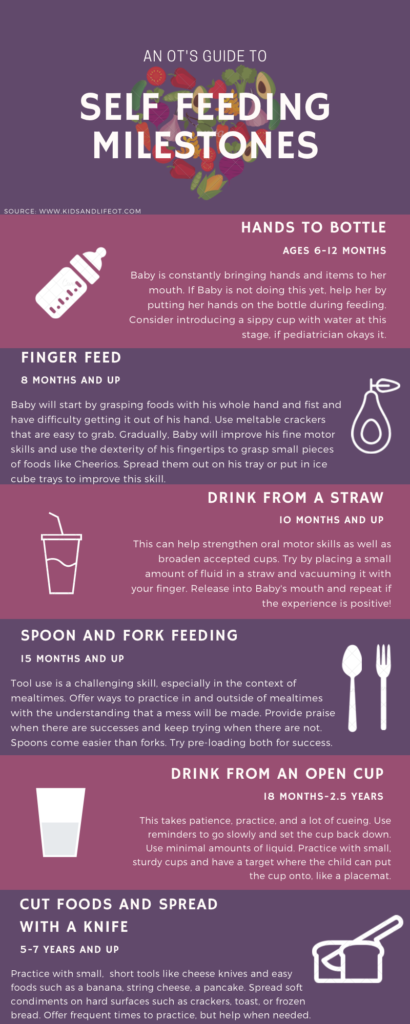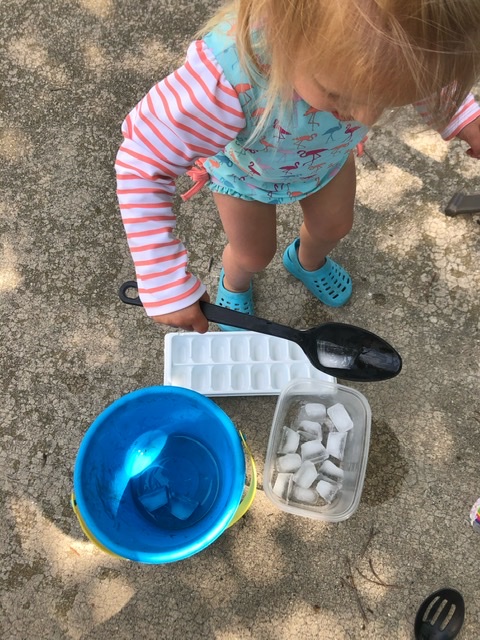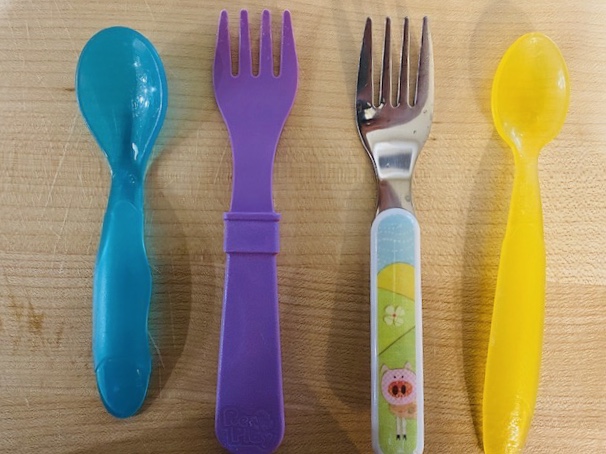Using utensils during a meal is a significant milestone. It means independence for the child and getting some more freedom as a parent! Keep reading for ways to support and encourage fork and spoon use for kids to feed themselves.
I’ll start by mentioning that self-feeding is not a goal for all parents or families. And if it is not, you do whatever works for your situation! Go ahead and find a different post 🙂
Mealtimes can be stressful for so many reasons. You spend a significant amount of time making a dinner, you have child(ren) running around, and then everyone comes to the table and should said child(ren) agree to eat what you made, some of them might only eat with their hands or refuse to feed themselves period. (Pssst…Check out my post on picky eating!)

Why do some kids not feed themselves?
As parents, we expect them to feed themselves at some point in their development. This is easier said than done for a lot of families. For some kiddos, this will not happen given their motor skills. For other kids, nutrition rules all. Caregivers so badly want and need to get their nutrition in, that self feeding is just not an option. And for those kids or teens, caregivers will do whatever they need to do to provide them with the nutrition they need. I will leave that one to you and your feeding team!
For other children, there’s likely one of a few reasons that an individual is not feeding themselves with utensils:
- feeding with hands is easier and more efficient
- eating is not enjoyable to them, therefore self feeding does nothing for them from a motivation standpoint
- from a motor or vision (or both!) perspective, they are unable to grasp a utensil, scoop or stab the food, and bring it up to their mouth
- they have gotten so used to a caregiver doing it for them, they prefer that (and can we blame them?), then they don’t practice, then it is a hard task, and the cycle continues
What are the benefits of self-feeding?
Self-feeding promotes independence in daily life skills. Right from the beginning, you are allowing your baby, toddler, child to decide what and how much to eat. This gives responsibility in the feeding process.
Also, this resource found that allowing self feeding from an early age suggests that toddlers are more willing to accept different tastes and textures. “…giving children opportunities to self-feed may facilitate food acceptance during toddlerhood.” This makes sense when we think about it: when a baby is able to control the food that goes into her mouth, she can take the time she needs to process the flavors, textures, temperatures as well as regulate how much more she wants. This allows for confidence in the feeding process!
And then, of course, the idea that practice will lead to independence. This means that YOU are required to do less. Here’s a quick guide for knowing when to introduce self feeding concepts and tasks.

So. It is going to take time to help the child in your life feed themselves (successfully!) with a utensil. It’s going to be messy. There will be dropped/thrown items out of frustration or curiosity. There could be tears (from both parent and child). But, try these suggestions and approaches and you should be on your way to more success with a fork and spoon.
6 Ideas to Promote Utensil Use
*This post contains affiliate links and I may receive commission when you click on links and make purchases. However, this does not impact the price you pay!
Start Early
Provide spoons and teethers to Baby when you start solids. He will not use them appropriately. But Baby will bring it to his mouth and chew, mouth them, and explore orally. He may pass it between hands or bang it on the tray. Feel free to put a little puree on that spoon and give him success when bringing the spoon to his mouth.

To begin, use utensils that have short, fat handles and a bowl of the spoon that is shallow and flat. Here are some that are great:
- Ezpz tiny spoons (honestly, I love all of their stuff. I’d buy it all if I were you.) You’ll hear about Ezpz again from me…
- Num Num Gootensils– barely spoons but just dippers and teethers, but they will translate excellently to a spoon.
- Grabease utensils– the cutest things you ever did see
- Silicone or mesh teethers- not utensils at all, but it combines the grasp-bring-to-mouth-and-taste-something activity strengthening independent self feeding
Strengthen Skills for General Tool Use
By practicing use of tools other than a fork and spoon, the child is strengthening grasp and the coordination of holding onto something and doing another task with it. Here are some ideas:
- Xylophone, drumstick and drums, or other musical instruments
- Coloring- scribbling, chalk, bingo dabbers
- Paint brushes or stampers- this offers the dipping motion similar to loading a spoon
- Hammer and other hardware tools
- Bubble wand
- Hairbrush and toothbrush on self, dolls, or animals
Practice Outside of Mealtimes
The act of self feeding takes a lot of skill including grasp, visual planning and motor execution. Put spoons, serving spoons, measuring cups, scoops, shovels into water play and the bathtub, sandboxes, sensory bins, water beads. This allows for the practice of scooping and dumping and spoon use with zero expectation of eating.

Choose the Right Utensils and Dishes
The spoons mentioned above will definitely work for babies, but they will likely become too small at some point for toddlers and kids. Most all kid utensils will work. But, if your child has a motor difficulty, there are some things that might be helpful to improve her success depending on her needs.
- curved handled spoons
- spoons with deep bowls for small pieces of food like pees and cut up cooked carrots (we refer to this type of spoon as our “Pea Spoon” and she’ll actually request it)
- weighted utensils are great for kiddos with coordination difficulties, have tremors, or have sensory processing differences
- Eazy Holds if your child has difficulty maintaining a grasp on the utensil
- silicone plates, bowls and placemats (I like Ezpz mentioned above or Nuby)
- divided plates or high lipped plates
- toothpicks, pretzel rods or sticks, popsicle sticks, or kabob sticks to poke chunks of cheese or hot dog circles
- dippable foods! Start with foods to dip into condiments to get the action down. Think about graham cracker sticks into yogurt, carrot sticks into hummus, teddy grahams into pudding, chicken nuggets or French fries into ketchup. You get the picture.
Strategically Choose your Foods
Depending on the skill you are working on, choose the foods that are easiest to scoop or stab to offer the most success. When he is scooping, choose sticky foods like yogurt and oatmeal. These don’t require much scooping or motor control to get it on the spoon. When he is stabbing, choose foods that are easy to stab and stay on the fork like cut up hot dogs, watermelon, pancake or waffle squares (motivating to dip in syrup too!), chicken squares, cheese cubes, apple chunks.
Consider making a rule that with motivating foods, utensils are required. For example, “We eat our pudding with a spoon!”
Routine, Repetition, Rewards
I say this a lot: keep at it. Continuing with the same expectations establishes an understanding and creation of new rules and standards. When kids know what is expected and it is repeated, they get used to it. It might be rough to start, but continue encouraging! Here are some ideas to get you started in creating a new expectation and routine:
- Offer lots of praise with successful attempts. This offers reinforcement of the behavior that is desired.
- Provide hand over hand assistance. This is literally how it sounds: you use your hand over (or under!) his hand to bring the spoon to his mouth.
- Encourage 1-3 bites, then done (then allow her to eat with her hands, someone else feed her, give hand over hand help, or do what you need to do to get through the mealtime and get appropriate nutrition).
- Consider rewarding small successes. Use sticker charts, a special treat at the end of the meal, or a special outing. Whatever is appropriate for your child’s interest and ability level.

Self-feeding is a challenging skill. It takes time and practice which can be hard to facilitate as a parent. Mealtimes are stressful and I understand this first hand. Continue working at it. Set the expectation and stick with it. The child in your life just may surprise you!
Case-Smith, J., & O’Brien, J. C. (2014). Occupational therapy for children. Place of publication not identified: Mosby.
The Role of Self-Feeding in Food Acceptance Among Toddlers


